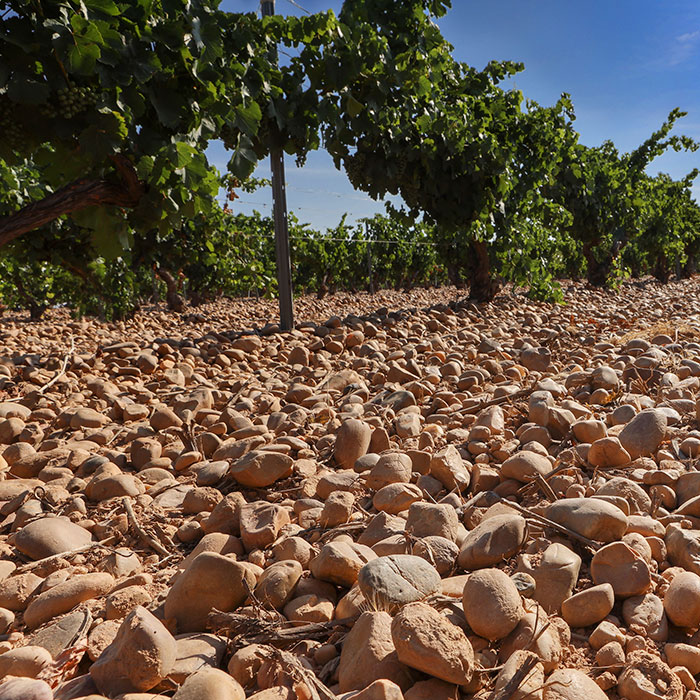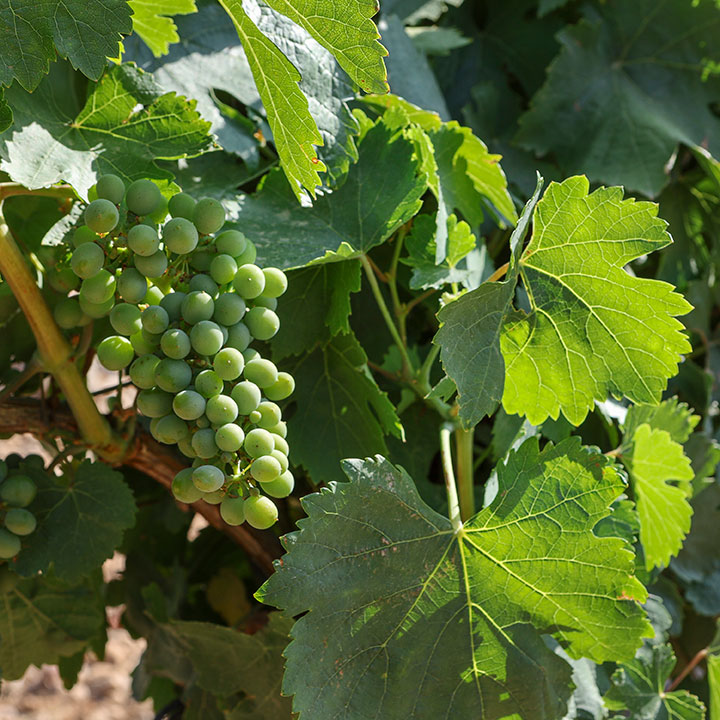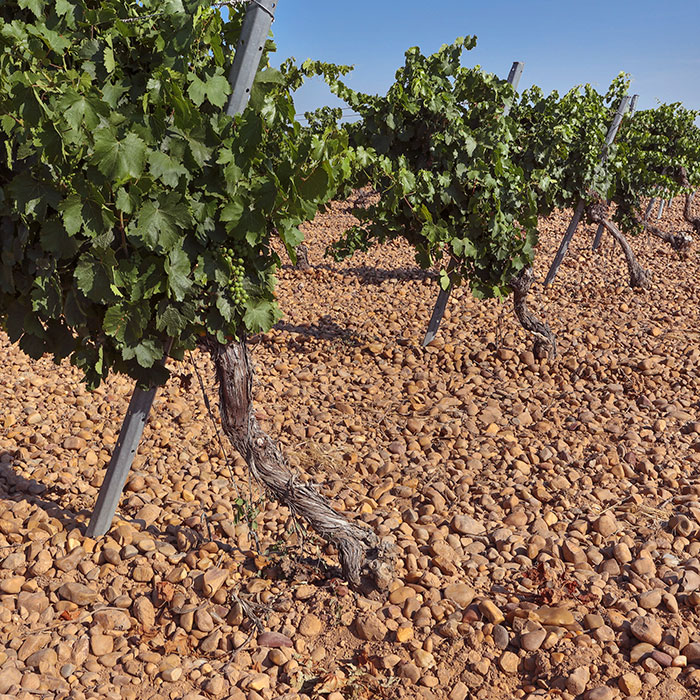The DO Rueda has conquered the restaurants and tapas bars of Spain with its white wines from the Verdejo grape variety. Within 50 years, its style has developed with fresh, medium-bodied and fruity wines with animating acidity. We present the most interesting wines.

The Rueda region is located on the south bank of the Duero River on a plateau between 700 and 930 metres above sea level. The landscape is predominantly flat but high, with gentle reliefs and hills where Atlantic winds blow. The soil consists of calcareous and stony alluvial terraces with a texture that varies between sandy and clayey. The terroir is permeable to air and water and easy for the winegrowers to work. This prevents fungal diseases and encourages the vines to seek water in the depths. In the southeast of the region, in the province of Segovia, the vines are rooted in sandy soils. In most of the area in the province of Valladolid, the soils are characterised by pebbles: The characteristic "suelo cascajoso" (pebble soil) is typical of the DO Rueda terroir.
The climate is continental: winters in the region are cold and very long. Spring tends to be short, but there is always the risk of late frosts, which rarely harm the vines because of the late budding. In contrast, summers are hot, dry and often accompanied by thunderstorms. Precipitation is scarce: Rainfall is only between 400 and 500 litres per year.
One of the most important climatic characteristics of the region is the large temperature difference between day and night caused by the high altitude vineyards. This ensures that, despite the hot, dry summers with an average of 2,600 hours of sunshine a year, the sugar levels in the grapes do not go through the roof - and, of course, the acidity is preserved. The late development of ripeness also favours harvesting at moderate temperatures, which often even takes place at night. In this way, even with high aromatic ripeness, wines with freshness and nerve are produced that are easy to drink.
The uninterrupted wine tradition in the Rueda dates back to the 11th century, when the first vineyards were planted after the Reconquista. In the 15th century, at the time of Isabella I of Castile, the wines were so sought after and precious that they were protected by royal decree. According to Hugh Johnson, this probably ensured the first establishment of a protected wine region. For as late as the 17th century, the Spanish royal family claimed half of the production for itself.

Before the appearance of phylloxera, the vineyards covered about 90,000 hectares and included both red and white varieties. A special feature of viticulture at that time were the "creeping" vineyards. They formed a typical Castilian landscape with small green hills that blended into one another. The oxidative wines with long maturation were particularly successful at the end of the 19th century. They are comparable to those from Jerez and Málaga and have always been known as "vino dorado" (golden wine). In fact, there was a very active wine trade between the two regions at the time.
After the appearance of phylloxera, which destroyed almost all the vineyards, the intensive trade made it easier for the winegrowers to replant them with the Jerez-typical grape variety Palomino. It still plays a role in the area today, but has been displaced above all by Verdejo, which now occupies around half of the vineyard area. The tradition of oxidative wines, however, remained alive in the region. Gradually, however, consumer tastes began to change: Fresher, fruitier wines, as known from France, were increasingly in demand. To promote this style, the Viura grape variety was imported from Rioja in order to make the wines in oak barrels in this style.
Finally, the success of the wines of this new style from Rueda aroused the interest of Francisco Hurtado de Amézaga de Riscal. He was the owner of the great Rioja winery Marqués de Riscal. Hurtado, oenologist and technical director of the Rioja winery, had been looking for a place to produce high-quality white wines on a large scale for years. Initially, his cuvée consisted of Viura and traditional Verdejo. The wines were matured for a short time in used oak barrels. This new orientation culminated in 1980 in the founding of the DO Rueda, which was also promoted by the Bodega Marqués de Riscal.
At the beginning, the DO Rueda covered about 10,000 hectares, but due to its great success, the area has doubled since then. The Verdejo played an increasingly important role and largely displaced the Viura again. Over the years, the style was also refined: now the winemakers focus on lighter, brighter and even fresher wines with striking acidity. Under the influence of the legendary Bordelais oenologist Émile Peynaud, however, ageing in oak barrels was largely abandoned. Vinification in the then new, modern steel tanks with controlled temperatures prevailed.

When visiting the region, one is struck by how large the vineyards are. Rows of steel tanks, each holding 100,000 litres, are almost the norm. This is because there are around 1,580 winegrowers, but only 79 wineries; even family businesses sometimes process bought-in grapes from several hundred hectares. In the glass, however, it becomes apparent that large production volumes and high quality need not be a contradiction.
Today, white wines account for 98 percent of the production of the DO Rueda, more than 80 percent of the vineyard area is planted with Verdejo. In second place comes Sauvignon Blanc with ten percent. Viura is in third place with five percent, followed by small amounts of Palomino, Viognier and Chardonnay.
Verdejo typically produces greenish-yellow to straw-yellow wines with a great aromatic potential of fruity notes ranging from white fruits (pear and apple) to stone fruits such as nectarine as well as melon. They are often accompanied by aniseed and fennel nuances as well as a pleasant hint of aromatic bitter notes that are characteristic of the variety. The Sauvignon Blanc contributes green, vegetal and exotic-fruity notes. The proportions of both varieties can vary greatly in the wines, but single-varietal wines made from Verdejo are also very common.
With this style, the DO Rueda has created its own category, the Gran Vino de Rueda, which is aimed at upscale gastronomy. The wines with the characteristic black back label come from vineyards that are over 30 years old, with yields of less than 6,500 kg/ha and a kilogram to litre ratio of no more than 65 percent. With these wines, the DO Rueda offers added value to the consumer and demonstrates the great versatility and storability of the autochthonous Verdejo grape variety. The 2020 and 2021 vintages are already on sale.
In addition, ancient vineyards and plots have been replanted in recent years. In some areas with sandier soil, there are even still ungrafted vines from the time before phylloxera. These plots are vinified separately and treated with special care. All this creates the character of the Rueda wines, which expresses itself with fruit, a mineral base as well as a special depth and longevity. These distinctly sophisticated Rueda varieties have not been available for long, but they add a new dimension to the region's success story.
 Familia Martínez Bujanda
— Castilla y León
2020 D.O. Rueda Verdejo Finca Montepedroso "Enoteca"
91 WP
excellent
38.60 €
Familia Martínez Bujanda
— Castilla y León
2020 D.O. Rueda Verdejo Finca Montepedroso "Enoteca"
91 WP
excellent
38.60 €
 Bodegas Val de Vid
— Castilla y León
2022 D.O. Rueda Verdejo "Condesa Eylo Barica"
88 WP
very good
Up to 15.00 €
Bodegas Val de Vid
— Castilla y León
2022 D.O. Rueda Verdejo "Condesa Eylo Barica"
88 WP
very good
Up to 15.00 €
 Bodegas Val de Vid
— Castilla y León
2022 D.O. Rueda Verdejo "Condesa Eylo"
86 WP
very good
Up to 10.00 €
Bodegas Val de Vid
— Castilla y León
2022 D.O. Rueda Verdejo "Condesa Eylo"
86 WP
very good
Up to 10.00 €
 Bodegas Val de Vid
— Castilla y León
2022 D.O. Rueda "Eylo"
86 WP
very good
Up to 7.50 €
Bodegas Val de Vid
— Castilla y León
2022 D.O. Rueda "Eylo"
86 WP
very good
Up to 7.50 €
 Familia Martínez Bujanda
— Castilla y León
2022 D.O. Rueda Verdejo Finca Montepedroso
87 WP
very good
8.15 €
Familia Martínez Bujanda
— Castilla y León
2022 D.O. Rueda Verdejo Finca Montepedroso
87 WP
very good
8.15 €
 Bodegas Marqués de Cáceres
— Castilla y León
2022 D.O. Rueda Verdejo "excellens"
84 WP
good
Up to 10.00 €
Bodegas Marqués de Cáceres
— Castilla y León
2022 D.O. Rueda Verdejo "excellens"
84 WP
good
Up to 10.00 €
 Martivillí
— Castilla y León
2022 D.O. Rueda Verdejo "Martivilli"
85 WP
very good
Up to 15.00 €
Martivillí
— Castilla y León
2022 D.O. Rueda Verdejo "Martivilli"
85 WP
very good
Up to 15.00 €
 Protos
— Castilla y León
2022 D.O. Rueda Verdejo
86 WP
very good
7.70 €
Protos
— Castilla y León
2022 D.O. Rueda Verdejo
86 WP
very good
7.70 €
 Marqués de Riscal
— Castilla y León
2022 D.O. Rueda Verdejo "Limousin"
88 WP
very good
19.20 €
Marqués de Riscal
— Castilla y León
2022 D.O. Rueda Verdejo "Limousin"
88 WP
very good
19.20 €
 Rodríguez y Sanzo
— Castilla y León
2021 D.O. Rueda Verdejo "Bajo Velo"
90 WP
excellent
Up to 25.00 €
Rodríguez y Sanzo
— Castilla y León
2021 D.O. Rueda Verdejo "Bajo Velo"
90 WP
excellent
Up to 25.00 €
 Rodríguez y Sanzo
— Castilla y León
2022 D.O. Rueda Verdejo "El Quinto Paraje"
88 WP
very good
Up to 15.00 €
Rodríguez y Sanzo
— Castilla y León
2022 D.O. Rueda Verdejo "El Quinto Paraje"
88 WP
very good
Up to 15.00 €
 Bodegas Muelas Tordesillas
— Castilla y León
2022 D.O. Rueda Verdejo Blanco "MVEDRA"
86 WP
very good
Up to 7.00 €
Bodegas Muelas Tordesillas
— Castilla y León
2022 D.O. Rueda Verdejo Blanco "MVEDRA"
86 WP
very good
Up to 7.00 €
 Familia Torres
— Castilla y León
2022 D.O. Rueda Verdejo "Pago del Cielo - Celeste"
85 WP
very good
Familia Torres
— Castilla y León
2022 D.O. Rueda Verdejo "Pago del Cielo - Celeste"
85 WP
very good
 Bodega Cuatro Rayas
— Castilla y León
2021 D.O. Rueda Verdejo "Longverdejo - Gran Vino de Rueda"
88 WP
very good
17.50 €
Bodega Cuatro Rayas
— Castilla y León
2021 D.O. Rueda Verdejo "Longverdejo - Gran Vino de Rueda"
88 WP
very good
17.50 €
 Bodega Cuatro Rayas
— Castilla y León
2022 D.O. Rueda Verdejo "Blanco Laseca"
85 WP
very good
Up to 7.00 €
Bodega Cuatro Rayas
— Castilla y León
2022 D.O. Rueda Verdejo "Blanco Laseca"
85 WP
very good
Up to 7.00 €
 Bodega Cuatro Rayas
— Castilla y León
2022 D.O. Rueda Verdejo "Organic"
86 WP
very good
Up to 9.00 €
Bodega Cuatro Rayas
— Castilla y León
2022 D.O. Rueda Verdejo "Organic"
86 WP
very good
Up to 9.00 €
 Bodegas y Viñedos Tamaral
— Castilla y León
2022 D.O. Rueda Verdejo
88 WP
very good
Up to 10.00 €
Bodegas y Viñedos Tamaral
— Castilla y León
2022 D.O. Rueda Verdejo
88 WP
very good
Up to 10.00 €
 Bodega Cuatro Rayas
— Castilla y León
2022 D.O. Rueda Verdejo "Viñedos Centenarios"
87 WP
very good
Up to 10.00 €
Bodega Cuatro Rayas
— Castilla y León
2022 D.O. Rueda Verdejo "Viñedos Centenarios"
87 WP
very good
Up to 10.00 €
 Bodega Cuatro Rayas
— Castilla y León
2022 D.O. Rueda Verdejo "Vendimia Nocturna"
87 WP
very good
Up to 10.00 €
Bodega Cuatro Rayas
— Castilla y León
2022 D.O. Rueda Verdejo "Vendimia Nocturna"
87 WP
very good
Up to 10.00 €
 Protos
— Castilla y León
2022 D.O. Rueda Verdejo Cuvée
87 WP
very good
9.95 €
Protos
— Castilla y León
2022 D.O. Rueda Verdejo Cuvée
87 WP
very good
9.95 €
 Marqués de Riscal
— Castilla y León
2022 D.O. Rueda Verdejo
84 WP
good
8.90 €
Marqués de Riscal
— Castilla y León
2022 D.O. Rueda Verdejo
84 WP
good
8.90 €
 Rodríguez y Sanzo
— Castilla y León
2022 D.O. Rueda Verdejo "Viñas viejas"
86 WP
very good
Up to 10.00 €
Rodríguez y Sanzo
— Castilla y León
2022 D.O. Rueda Verdejo "Viñas viejas"
86 WP
very good
Up to 10.00 €
 Martivillí
— Castilla y León
2022 D.O. Rueda Sauvignon Blanc "Martivilli"
87 WP
very good
Up to 15.00 €
Martivillí
— Castilla y León
2022 D.O. Rueda Sauvignon Blanc "Martivilli"
87 WP
very good
Up to 15.00 €
 Bodega Cuatro Rayas
— Castilla y León
2022 D.O. Rueda Sauvignon "Vendimia Nocturna"
86 WP
very good
9.50 €
Bodega Cuatro Rayas
— Castilla y León
2022 D.O. Rueda Sauvignon "Vendimia Nocturna"
86 WP
very good
9.50 €
 Bodegas Marqués de Cáceres
— Castilla y León
2022 D.O. Rueda Sauvignon Blanc "excellens"
87 WP
very good
Up to 11.00 €
Bodegas Marqués de Cáceres
— Castilla y León
2022 D.O. Rueda Sauvignon Blanc "excellens"
87 WP
very good
Up to 11.00 €
 Marqués de Riscal
— Castilla y León
2022 D.O. Rueda Sauvignon Blanc "Organic"
86 WP
very good
11.95 €
Marqués de Riscal
— Castilla y León
2022 D.O. Rueda Sauvignon Blanc "Organic"
86 WP
very good
11.95 €
 Bodegas Marqués de Cáceres
— Castilla y León
2020 D.O. Rueda Sauvignon Blanc "excellens"
85 WP
very good
Bodegas Marqués de Cáceres
— Castilla y León
2020 D.O. Rueda Sauvignon Blanc "excellens"
85 WP
very good
 Protos
— Castilla y León
2020 D.O. Rueda Verdejo
86 WP
very good
Protos
— Castilla y León
2020 D.O. Rueda Verdejo
86 WP
very good
 Bodega Cuatro Rayas
— Castilla y León
2018 D.O. Rueda Verdejo "Cuarenta Vendimias"
85 WP
very good
Bodega Cuatro Rayas
— Castilla y León
2018 D.O. Rueda Verdejo "Cuarenta Vendimias"
85 WP
very good